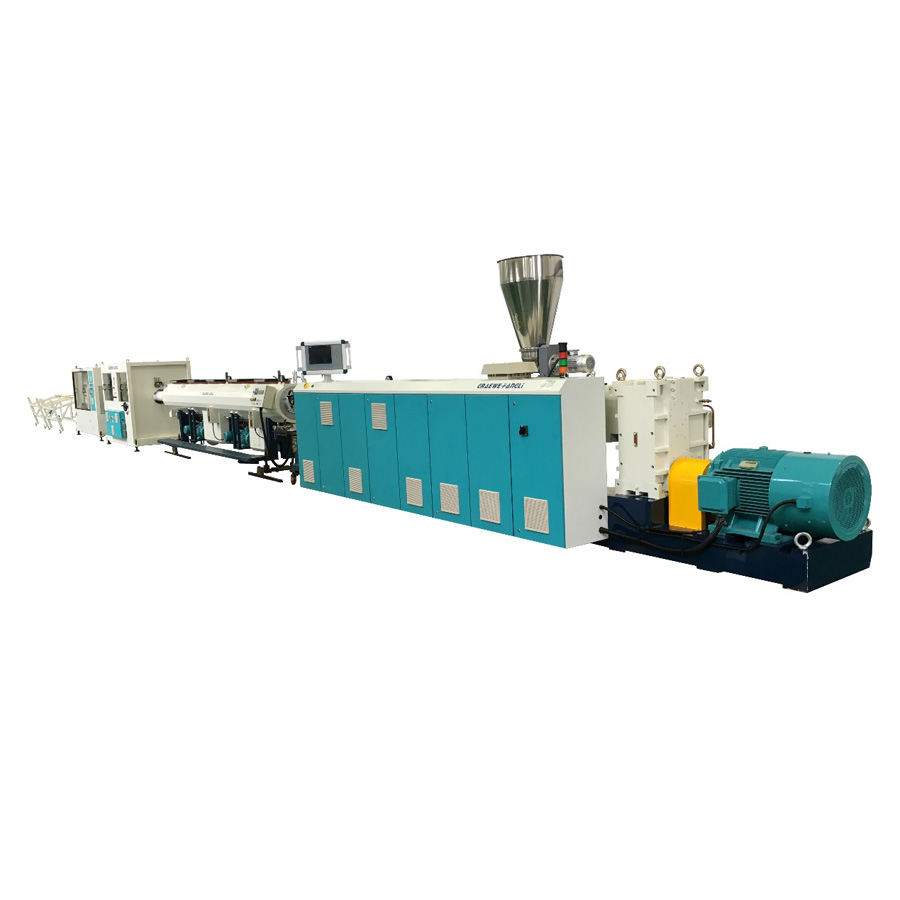Extrusion Line for Solid Wall Pipe: Revolutionizing the Manufacturing of Durable Pipes
2025-03-12
In today's modern construction, plumbing, and industrial sectors, pipes play a crucial role in delivering services like water, gas, and sewage management. For industries where durability and efficiency are essential, solid wall pipes are often the preferred choice. One of the most advanced technologies in pipe production is the extrusion line for solid wall pipes. This process involves shaping raw materials into solid pipes that are used in a wide range of applications.
In this blog, we will explore the benefits, components, and applications of extrusion lines for solid wall pipes, as well as why they are becoming increasingly important in the manufacturing of reliable, high-quality pipes.
What is an Extrusion Line for Solid Wall Pipe?
An extrusion line for solid wall pipe refers to a sophisticated system used to produce pipes by forcing raw materials (usually plastic or polymer) through a mold or die under high pressure. The material is heated to a specific temperature, ensuring that it becomes malleable, and is then pushed through a die to form the desired pipe shape. Once the material cools down, it hardens, retaining the shape of the mold, resulting in solid wall pipes that are ready for use.
Extrusion lines for solid wall pipes are typically used to produce pipes from materials like PVC (Polyvinyl Chloride), HDPE (High-Density Polyethylene), and PP (Polypropylene). These materials are known for their strength, chemical resistance, and long-lasting performance, which makes them ideal for a wide range of applications.
Key Components of an Extrusion Line for Solid Wall Pipes
The extrusion line for solid wall pipes is composed of several key components, each of which plays an important role in ensuring the smooth production process:
1. Extruder
The heart of the extrusion line, the extruder is a machine that melts and mixes the raw material. It uses a rotating screw to push the material through a heated barrel, turning the solid pellets or granules into a molten form. The extruder is critical for achieving the proper viscosity and consistency needed for pipe production.
2. Die and Head
The die is the tool that shapes the melted material into the desired pipe profile. For solid wall pipes, the die ensures that the walls of the pipe are uniform and the correct thickness. The die head is where the material is shaped, and it plays a vital role in determining the final dimensions of the pipe.
3. Vacuum Calibration Tank
After the material exits the die, it is still in a semi-soft form and needs to be solidified. The vacuum calibration tank uses a vacuum system to hold the pipe in place and cool it down to its final size. The vacuum helps maintain the pipe's shape and dimensions, ensuring a high level of precision.
4. Cooling System
To further cool the pipe, a water cooling system is used. The pipe is submerged in water or sprayed with cool water to reduce its temperature and solidify the material completely. This cooling step ensures that the pipe does not warp and maintains its shape after extrusion.
5. Cutting Unit
Once the pipe has been fully cooled and solidified, it moves to the cutting unit. The cutting unit is responsible for cutting the pipe into the desired lengths. This step is crucial for ensuring that the final product meets the required specifications and is ready for packaging or shipment.
6. Puller and Haul-off Unit
The puller or haul-off unit is responsible for pulling the pipe along the extrusion line during the production process. This component ensures that the pipe moves steadily through each section of the line, preventing sagging or stretching that could affect the pipe’s quality.
7. Control Panel
The control panel is the central hub for managing the extrusion line's operations. It allows operators to monitor and adjust parameters such as temperature, pressure, and speed to ensure optimal production conditions. Modern extrusion lines often come with advanced automation systems that improve precision and reduce the need for manual intervention.
Benefits of Using an Extrusion Line for Solid Wall Pipes
1. High Durability
Extruded solid wall pipes are known for their strength and durability. The extrusion process allows for consistent wall thickness and smooth finishes, resulting in pipes that can withstand high-pressure applications and harsh environmental conditions.
2. Cost-Effective Production
Once set up, an extrusion line can produce large quantities of solid wall pipes with high efficiency, making the process cost-effective. The automation of most tasks also reduces labor costs, making the overall manufacturing process more affordable.
3. Customization
One of the significant advantages of using an extrusion line for solid wall pipes is the ability to customize the pipes according to specific requirements. The extrusion process allows for flexibility in pipe size, wall thickness, and material composition. This customization makes it suitable for a wide range of industries and applications.
4. Sustainability
The extrusion process for solid wall pipes is environmentally friendly. Many extrusion lines use recycled materials in the production process, and the pipes produced are recyclable as well. This contributes to reducing waste and the overall carbon footprint of the manufacturing process.
5. Consistency and Quality Control
Extrusion lines for solid wall pipes offer a high degree of precision, ensuring consistent product quality. With the help of advanced monitoring systems and quality control measures, manufacturers can maintain uniform pipe dimensions and meet stringent industry standards.
Applications of Solid Wall Pipes
Solid wall pipes produced by extrusion lines are used in a variety of industries, including:
1. Plumbing and Drainage
Solid wall pipes made from materials like PVC and HDPE are widely used in plumbing systems, including water supply and drainage systems. These pipes are durable, resistant to corrosion, and easy to install, making them ideal for both residential and commercial plumbing projects.
2. Sewage and Wastewater Treatment
Solid wall pipes are also commonly used in sewage and wastewater treatment plants. Their resistance to chemical corrosion makes them suitable for transporting wastewater and other aggressive substances without degrading over time.
3. Telecommunications and Electrical
In the telecommunications and electrical industries, solid wall pipes are used for conduit systems that house cables and wires. These pipes protect the cables from environmental damage and provide a safe and secure pathway for electrical systems.
4. Agriculture and Irrigation
In agriculture, solid wall pipes are used in irrigation systems to transport water to crops. These pipes are durable enough to handle the pressures associated with irrigation systems and can be buried underground for long-term use.
5. Industrial Applications
In industrial sectors, solid wall pipes are used for transporting a variety of fluids, gases, and chemicals. The strength and corrosion resistance of these pipes make them ideal for use in manufacturing facilities, refineries, and chemical plants.
Conclusion
Extrusion lines for solid wall pipes are a crucial part of modern pipe manufacturing. With their ability to produce high-quality, durable pipes in large quantities, these lines are revolutionizing the way industries meet their pipe needs. From plumbing to irrigation and industrial applications, the versatility of solid wall pipes makes them an indispensable product across various sectors.
As industries continue to demand high-performance materials, extrusion technology will play an essential role in meeting those needs while ensuring sustainability and efficiency in production. Whether you're a manufacturer or a consumer, understanding the benefits and applications of extrusion lines for solid wall pipes can help you make informed decisions about the materials you use.



